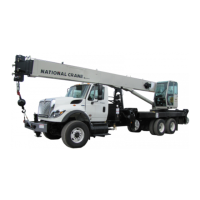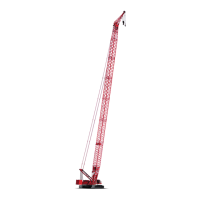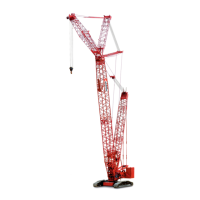Manitowoc Published 09-10-14, Control # 065-24 1-49
14000 SERVICE MANUAL INTRODUCTION
DRUM 3 (AUXILIARY/LUFFING JIB) SYSTEM
See Figure 1-29, and Figure 1-30 for the following
procedure.
Drum 3 is located in the boom butt. Drum 3 can be
configured for either luffing jib operation or as an auxiliary
load drum. If drum 3 is rigged for luffing jib operation it can
not be used as a load drum.
One hydraulic pump drives one motor gearbox on end of
drum shaft. The left travel pump is dedicated to operate drum
3 though a diverging valve. Left travel and drum 3 cannot be
operated at the same time. Hydraulic connections between
pump and motor form a closed-loop system that is controlled
with control handle movement and node controllers.
The far load drum control handle 3/4 on the right side
console operates drum 3 when configured as a load drum.
When configured as a luffing jib the control handle on left
side console operates drum 3 and the boom hoist operates
with far load drum control handle 3/4 on the right side
console. Drum 3 control handle is inoperable when drum 3
park brake is applied.
Charge pressure from system pump supplies hydraulic
make-up fluid to closed-loop. Low-side pressure supplies
hydraulic pilot pressure to operate motor servo. A pressure
sender in high-pressure side of pump leg provides system
pressure information to node 1 controller. A fixed orifice
between pump ports A and B allows for smooth drum
operation.
When drum 3 motor rotates, a speed sensor at motor rotor
monitors and sends an input voltage to node 1 controller to
control drum operation. Node 2 controller sends an output
voltage to rotation indicator in control handle. As drum
rotates faster, the rotation indicator on top of control handle
pulsates with a varying frequency that indicates drum
rotational speed. Handle command in percent from neutral is
shown on Diagnostic Screen.
Continuous changing of closed-loop fluid occurs with
leakage in pump, motor, and external sequence/flow valve.
Sequence/flow valve opens at 200 psi (14 bar) and removes
4 gallons per minute (15 l/m) of hot fluid from system by
discharging exhausted fluid into motor case where the fluid
returns to tank.
Drum 3 Brake and Pawl
Hydraulic pressure to operate drum 3 brake and drum pawl is
from low-pressure side of system. When drum 3 brake
switch is in on - park position, drum brake release solenoid
HS-7 is disabled so brake is applied to drum shaft. Drum 3
pawl in solenoid HS-9 is enabled to keep pawl applied to
drum flange. Drum pump does not stroke in response to
control handle movement.
When drum 3 brake switch is placed in off - park position,
brake release solenoid HS-7 remains applied until node 3
controller sends a 24 volt output to release the brake.
Node 3 controller also sends a zero volt output signal to
drum 3 pawl in solenoid HS-9 and a 24 volt output to enable
pawl out solenoid HS-8 to release pawl. Drum 3 circuit is
active, waiting for a control handle command.
Raising
When drum 3 control handle is moved back for raising, an
input voltage of 2.6 volts or more is sent to node 1 controller.
Node 3 controller sends a 24 volt output to enable drum 3/left
travel diverting solenoid HS-10 to shift selector valve to open
port to drum 3 motor and close port to left travel motor. This
also shifts directional control valve to open port to drum 3
pawl solenoid. Node 3 controller sends a 24 volt output to
enable drum 3 pawl out solenoid HS-08 to shift valve and
open port to disengage pawl.
Node 4 controller sends a variable 0 to 24 volt output that is
divided by resistors and applied to drum 3 pump EDC in the
raising direction. Node 3 controller sends a variable 0 to 24
volt output that is applied to drum 3 motor PCP. Node 1
controller checks that drum block-up limit switches are
closed and no system faults are present.
Pump EDC tilts swashplate in raising direction to satisfy
pressure memory. Node 1 controller compares drum holding
pressure to value in pressure memory. When system
pressure is high enough, node 3 controller sends a 24 volt
output to enable drum 3 brake release solenoid HS-7. Drum
brake solenoid shifts to block drain port and opens port to
low-pressure side of drum system to release brake from
drum shaft.
Drum 3 pump EDC tilts swashplate in raising direction as
hydraulic fluid flow is from pump outlet port B to motor inlet
port. Return fluid flow is from motor outlet port to pump inlet
port A.
Node 4 controller output voltage to pump EDC and node 3
controller output voltage to motor PCP is relative to control
handle movement. As control handle is moved back, an
output voltage increases the pump swashplate angle.
When system pressure exceeds the ECOR (electric
compensating over-ride) valve setting of 3600 psi (248 bar),
the valve shifts to direct flow from shuttle valve into maximum
displacement side of servo cylinder. The ECOR valve over-
rides the command from servo PC valve, increasing motor
displacement and output torque and reducing output speed.
When ECOR valve closes, control of the motor returns to
servo PC valve.
Node controllers continuously balance drum system
pressures and monitor motor displacement angle so motor
displacement goes to minimum when control handle is all the
way back, if motor torque requirements are not too high.
Node 1 controller monitors motor displacement and controls
motor speed by regulating hydraulic fluid flow through the
pump.

